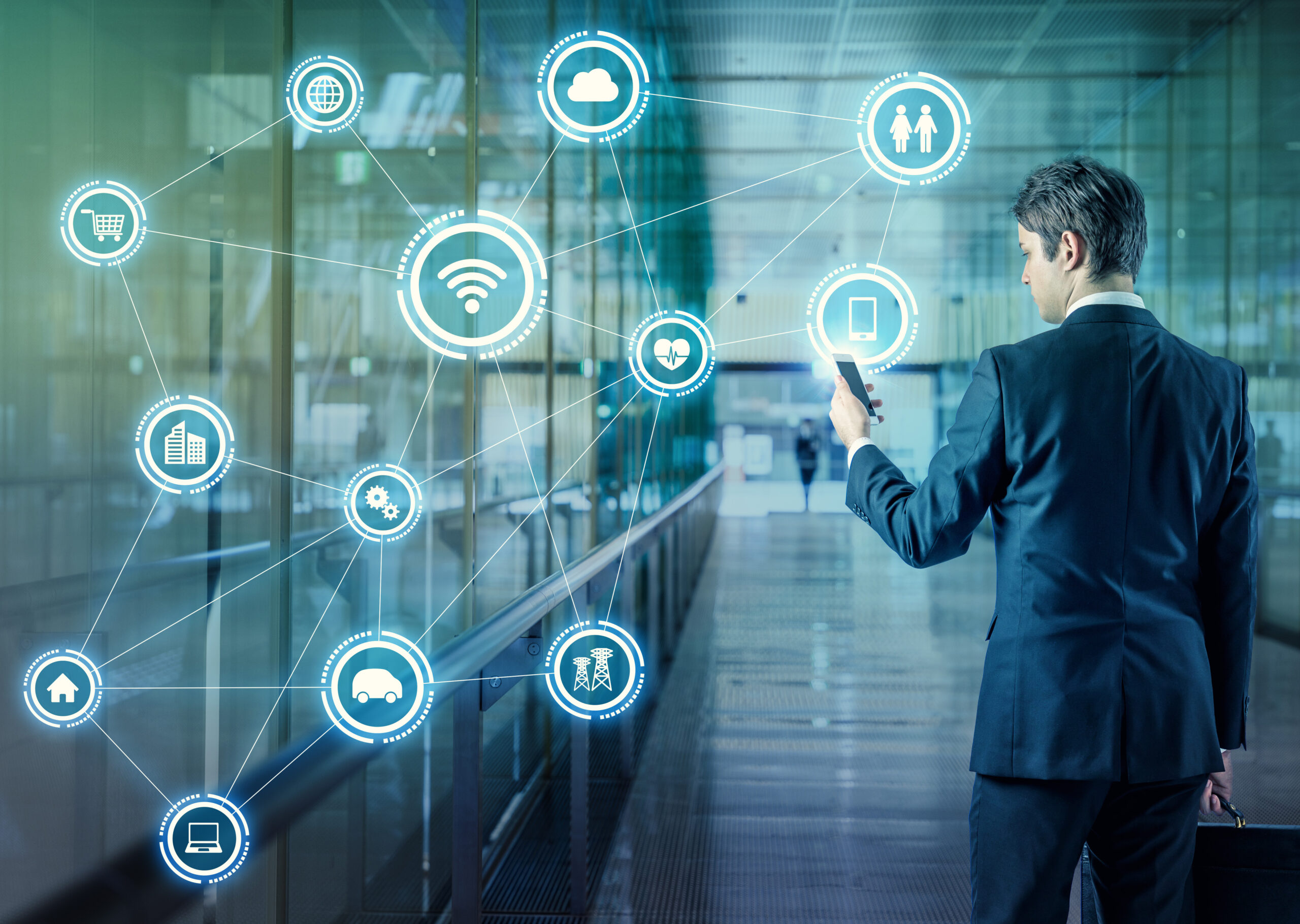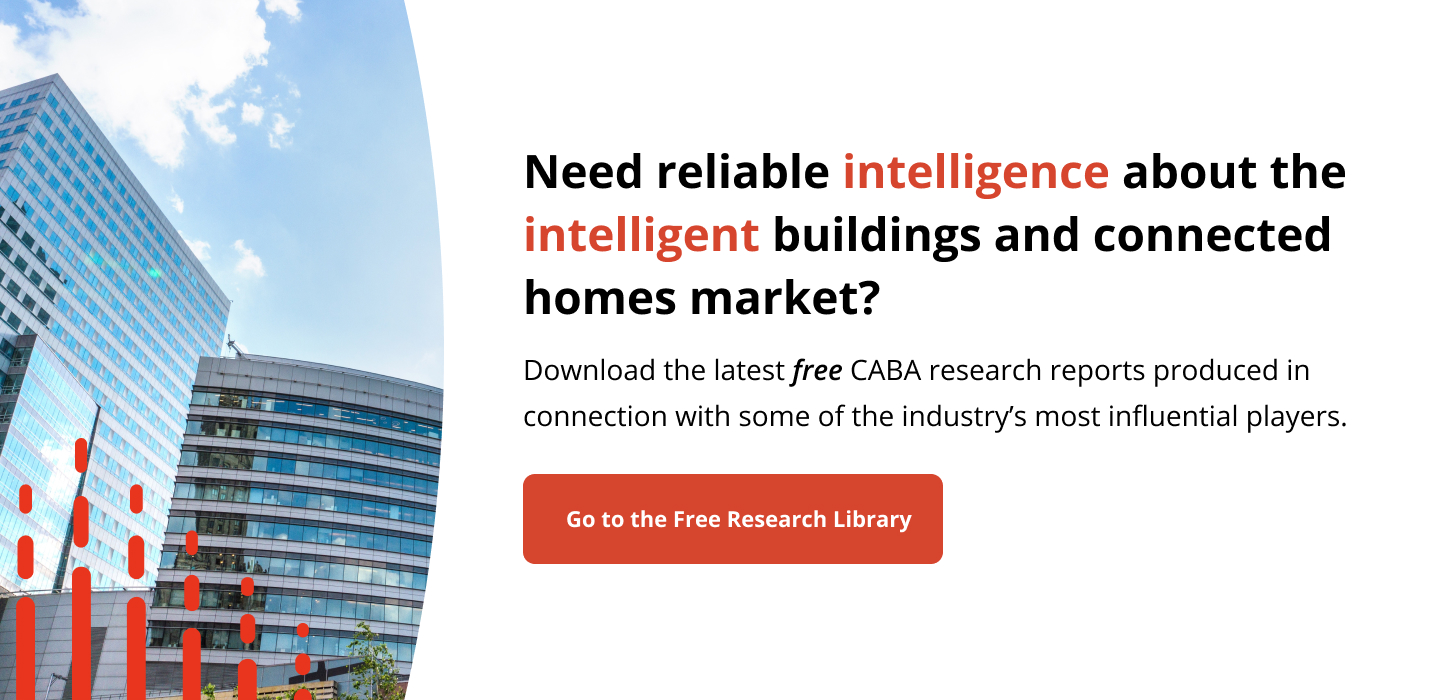A fundamental building block of intelligent infrastructure, IoT sensors are responsible for capturing the abundance of data that buildings and their occupants generate on a daily basis. All that data holds the key to an ocean of actionable insights, depending on the business challenge you’re trying to solve.
So how are most building owners leveraging these rich data streams currently, and what opportunities does that present for software vendors? To find out, we asked Nick Stefanidakis at SpaceIQ (a ASHB member) and Ibrahim Yate at research and advisory firm Verdantix about the top IoT sensors being used today and what customers are looking for from IoT vendors.
Get the latest insights on the intelligent building market from industry insiders—visit the ASHB Free Research Report Library.
Top IoT Sensor Devices
Occupancy Management
Both Yate and Stefanidakis agree that one of the most popular applications for IoT sensors now is occupancy management for the workplace.
Stefanidakis is General Manager of SpaceIQ’s Archibus platform, an integrated workplace management system (IWMS) that helps building owners/managers better manage their facilities and create more efficient workplaces. He’s seeing a lot more interest from his large corporate customers in sensors around occupancy management, which includes everything from knowing how many people are in a building currently and which desks are occupied to understanding traffic flow patterns and occupancy trends. Utilizing an IWMS with an open platform such as Archibus, organizations can easily integrate with sensor APIs and review sensor data alongside other space, asset, and maintenance data for a holistic view of the organization’s built environment.
He explains that building owners can integrate occupancy data into workflows. “For example, say someone has booked a desk for 9:00 A.M. If some amount of time later no one has actually sat down at that desk, we can release it and make it available for someone else. There are all sorts of use cases for that sensor data around occupancy, utilization, space planning, cleaning frequency, and many others.”
Yate, whose work has included conducting specialized industry research on space and workplace management, notes that this increased interest is largely due to COVID. “Not everyone’s going to be working from the office five days a week anymore; it’s actually going to become very difficult to justify that. As a result, many corporations are cutting down on the amount of real estate they own. So if you have less space but a similar amount of employees, and those employees aren’t always coming in at a set time, it’s almost a necessity that you need some form of technology to manage that. You need to be able to let people know which places are free.”
Another factor that plays into the trend is regulatory. “You can’t have a situation where a building is over capacity not only for fire safety reasons but also for COVID and healthy air reasons as well. There are some pretty significant drivers behind these trends—it’s not just market hype,” he says.
Environmental Monitoring
As Yate points out, COVID has prompted greater concern about building health. “A lot more corporations want to measure the quality of the air—especially in high-profile buildings like headquarters—and reassure clients and visitors that the local environment is being kept in good condition.” To do that, some sensors are being linked with HVAC systems to monitor the air quality, even measuring the cleansing of the air particles for an extra layer of protection. Yate also believes that, in the future, there will be tougher laws around HVAC operation. “If companies want to demonstrate compliance with that, they might start using sensors.”
But it isn’t just pandemic-driven, he says. “At a certain point, COVID is likely to go away or at least diminish as a threat. But that doesn’t mean the whole healthy building agenda isn’t important; people are just more aware of it now. COVID was the catalyst, but I think the healthy building concept will stick around for several years, at least.”
Stefanidakis notes that some occupancy sensors can also do some environmental monitoring—CO2, noise, lighting, and temperature. “Temperature is the most common complaint from employees—it’s either too hot or too cold. If you can measure the real temperature versus the set points you have set in the HVAC system, then you can begin to understand how your building responds to real-time conditions and occupancy load. So if the building is 85%–90% occupied, it takes a lot more to cool that building. Having that real-time feedback is a really great tool.”
Energy Management
Energy waste is of concern to most building owners, but there’s no single sensor that is identified as an “energy management sensor,” says Stefanidakis. Instead, the data from numerous sensors can be tied into one another for purposes of energy management. For example:
- Sensors for HVAC monitor the position of dampers.
- Environmental sensors determine whether more outside air should be pulled in or identify air quality issues.
- Occupancy data determines building needs. If a building is empty, you can dial back the HVAC. If you can manage things by floor, you might try to fill the fourth floor before you start letting people into the fifth floor and then cooling (or heating, as needed) the fifth floor.
All of the above sensors work together to produce various data points that can be used to improve overall energy consumption, he explains. “And then there are the energy meters themselves, which are sensors. So if you’re just tracking 15-minute interval data on energy meters, and you see that consumption or demand has gone up in an abnormal fashion, that might be a trigger to send somebody and figure out what’s going on.”
Types Of IoT Sensor TechnologiesAside from the conditions being monitored, there are also different types of sensor technologies. For decades, the most common type was (and in some ways still is) the passive infrared (PIR) sensor. Equipped with microscopic sensing capability, PIRs are used to detect movement, such as when someone walks past a light and it turns on, then turns off when no movement is detected for a period of time. While they are not highly sophisticated, PIRs have a number of solid use cases. Increasingly, however, customers in many high-tech hubs—including San Francisco, New York, and Boston—are adopting camera sensors. These sensors actually take a photo, which is then analyzed by software to determine, for example, available spaces within a building. The type of technology you choose depends on a variety of factors, says Yate. Wired vs. wireless sensors vary in terms of the level of maintenance needed and the ease of deployment. And even though a camera sensor is more expensive, it may still be more economical to employ it for occupancy monitoring. (One camera mounted to the ceiling can monitor multiple desks, while a PIR sensor would need to be attached to each individual desk.) “Camera sensors are also a lot more expensive than PIR sensors, but they’re a lot more accurate. If someone is standing next to an otherwise empty desk talking to someone else, the PIR sensor doesn’t know how to detect whether or not the desk is free; however, certain camera sensors can actually detect if that person is not sitting down. All these features and these technological aspects have big implications for the actual customers of these products.” |
Choosing IoT Sensor Products
Yate’s research has shown that the workplace and space management software market continues to experience high growth rates—with a list of participating firms that includes (but is not limited to): Accruent, AREMIS, Brivo, eCIFM, essensys, FM:Systems, FSI, Honeywell, IBI Group, IBM, Infogrid, iOFFICE, JLL, Locatee, MRI Software, Nuvap, Nuvolo, Openpath, Planon, Rapal, Ricoh, Schneider Electric, ServiceNow, Siemens, SpaceIQ, Spacewell, Spica Technologies, Tango, Thing Technologies, ThoughtWire, VergeSense, and WeWork. Suppliers need to plan for an increasingly competitive market. Among other things, buyers consider the following factors when choosing IoT sensor devices:
- Is the product tailored to your specific needs? Some platforms in the smart building space talk about buildings generically, while others dominate specific segments like retail, education, or healthcare, for example. Specialty solutions are better equipped to handle the distinct use cases that go along with certain industries.
- Will you need different providers for different sensing purposes? Many different manufacturers offer PIR sensors, says Yate, because they’re practically a legacy product. But if you want to start using camera sensors, it’s best to go to specific providers who have expertise in deploying them.
- Do they have good APIs? Typically, the sensor vendors themselves provide analytics. But it’s often more useful to be able to integrate that data into your space planning tools, as opposed to just standalone analytics. APIs enable you to share data with multiple building systems.
- Does it provide historical data, real‑time data, or both? Historical data is useful for analytics, whereas real‑time data is important for workflow (“Where are the available desks?”). It’s important to have both types of data available.
- What is the cost? The packaging of sensors varies and determines the overall cost: How is the service being sold? Are you making a capital investment in purchasing the sensors and then subscribing to a service for the data, or is it a turnkey subscription that includes everything—batteries, service, hardware, software analytics, etc.?
- How is the data being secured? With regard to sensors and privacy, it’s important to understand where the data is being processed. Is the platform sending imagery or personally identifiable information (PII) back to its service, or are analytics being done on the device or at the gateway? Is the data being sent across the internet harmlessly, or using a digital infrastructure from a service provider with proven cybersecurity accreditations? Today, most sensor vendors do a good job of handling security and avoid exposing any PII data in transit.
IoT Sensors For Future Planning
Aside from the applications discussed above, Yate notes that building or occupancy sensors can also serve another purpose: to inform future office designs and architecture.
“For example, you could collect lots of data from sensors and then measure up the ratio of the amount of actual space that was used for desks, private focus areas, and rooms for collaboration. By measuring those things, you can redesign a workspace to match how occupants actually use it.”
For the moment, however, IoT sensor products are helping building owners navigate more imminent issues, says Stefanidakis. “Most of the requests that we see today are around how to manage the office of the future. So many people now are insisting on some amount of remote work, and companies don’t know yet what the demand is going to be for space. Occupancy management sensors help [owners] plan for their future portfolio needs by leveraging real data, rather than just making plans based on what department managers might be telling them.”
Get more of the latest insights on intelligent buildings from ASHB.
A leading international association for the smart buildings market, ASHB works closely with OEMs, software providers, integrators, building operators, and other industry stakeholders to identify and explore the latest developments and trends in the industry. To learn more about the top IoT sensors and other topics related to smart buildings, visit our Free Research Report Library, which contains case studies, consumer surveys, research papers, and more. To get access to even more competitive insights, we encourage you to become a ASHB member.



